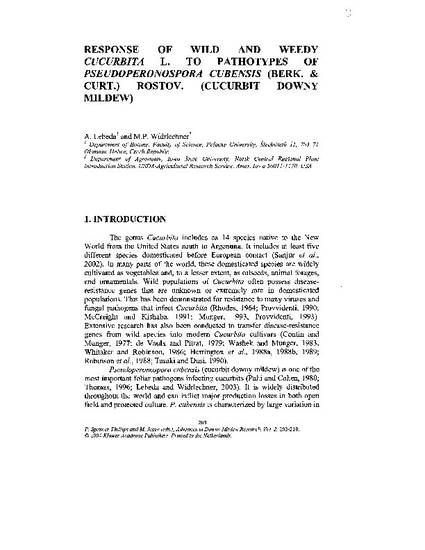
Contribution to Book
Response of Wild and Weedy Cucurbita L. to Pathotypes of Pseudoperonospora Cubensis (Berk. & Curt.) Rostov. (Cucurbit Downy Mildew)
Advances in Downy Mildew Research
Document Type
Book Chapter
Disciplines
Publication Version
Published Version
Publication Date
1-1-2004
Abstract
The genus Cucurbita includes ca 14 species native to the New World from the United States south to Argentina. It includes at least five different species domesticated before European contact (Sanjur et al., 2002). In many parts of the world, these domesticated species are widely cultivated as vegetables and, to a lesser extent, as oilseeds, animal forages, and ornamentals. Wild populations of Cucurbita often possess disease-resistance genes that are unknown or extremely rare in domesticated populations. This has been demonstrated for resistance to many viruses and fungal pathogens that infect Cucurbita (Rhodes, 1964; Provvidenti, 1990; McCreight and Kishaba, 1991; Munger, 1993; Provvidenti, 1993). Extensive research has also been conducted to transfer disease-resistance genes from wild species into modern Cucurbita cultivars (Contin and Munger, 1977; de Vaulx and Pitrat, 1979; Washek and Munger, 1983; Whitaker and Robinson, 1986; Herrington et al., 1988a, 1988b, 1989; Robinson et al., 1988; Tasaki and Dusi, 1990).
Rights
Works produced by employees of the U.S. Government as part of their official duties are not copyrighted within the U.S. The content of this document is not copyrighted.
Language
en
File Format
application/pdf
Citation Information
A. Lebeda and M. P. Widrlechner. "Response of Wild and Weedy Cucurbita L. to Pathotypes of Pseudoperonospora Cubensis (Berk. & Curt.) Rostov. (Cucurbit Downy Mildew)" Advances in Downy Mildew Research Vol. 2 (2004) p. 203 - 210 Available at: http://works.bepress.com/mark_widrlechner/94/

This is a chapter from Advances in Downy Mildew Research 2 (2004): 203.